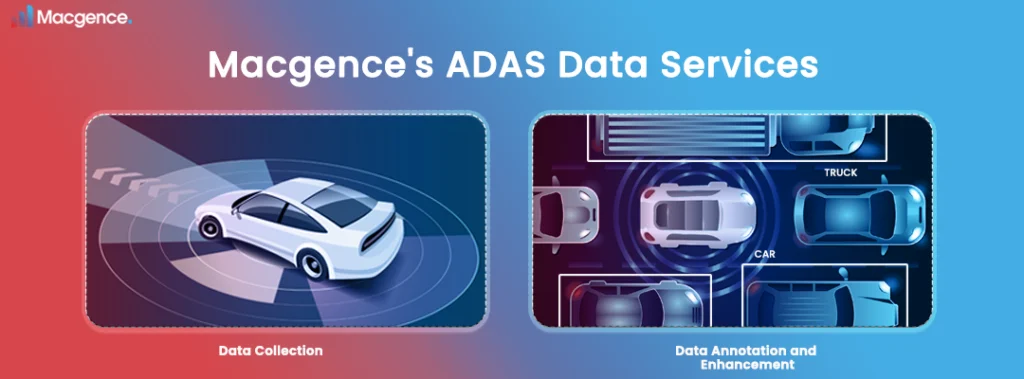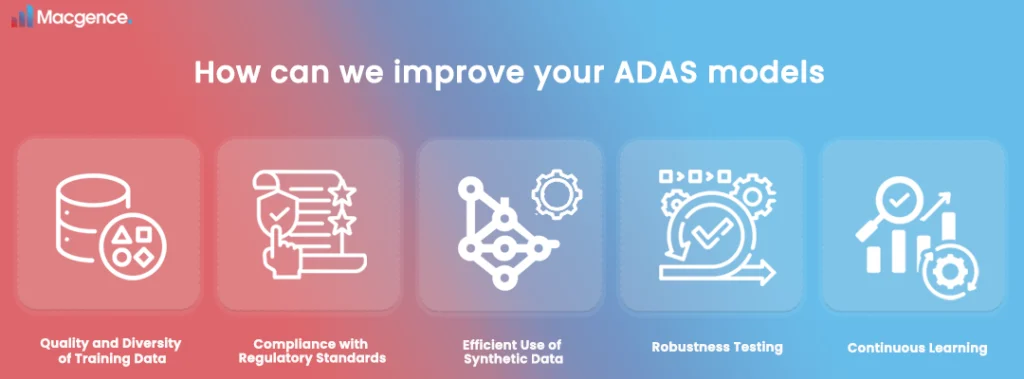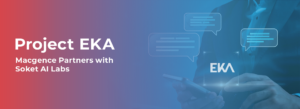Future Proof Your Road Safety with Advanced Driver Assistance Systems (ADAS)
Most injuries associated with vehicles manifest because of human error. Although you can’t save all vehicular accidents, you may avoid a significant part of them. Technology, consisting of Advanced Driver Assistance Systems training data and a machine-human innovative interface, is helping drivers improve their capability to predict, assess, and react to road risks. Its industry doubled between 2015 and 2020, reaching $17 billion in 2020. Furthermore, its marketplace is projected to touch $32 billion by 2023. This blog will cover ADAS, the most critical aspect of AI-trained data for ADAS models, why Macgence steps one step ahead of others, and much more.
What do you mean by ADAS?
It is an intelligent system built into the car design that assists the driver in driving and reducing vehicular accidents. ADAS training data provide crucial information to the driver about traffic, road closure, congestion warnings, and alternative routes. These datasets also accurately judge drivers’ fatigue levels and distractions and provide alerts and suggestions regarding their driving.
Importance of AI-Trained Data for ADAS Models

At the core of building effective models lies the critical step of amassing vast quantities of ADAS training data, essential for data-intensive operations like deep learning training and inference. This process equips ADAS systems with the capability to perform complex tasks such as object identification and voice and image recognition. The development of autonomous driving systems, capable of navigating diverse scenarios, relies on extensive labeled and unlabeled training datasets, ADAS training data supplemented by synthetic data simulating real-world conditions.
Numerous labeled and unlabeled training datasets and ADAS training data are the foundation for developing autonomous driving systems that interpret and respond effectively to real-world situations. Synthetic data from multiple sensors supplements the training process, enhancing the model’s adaptability to a broad spectrum of driving environments. Its substantial market growth is intricately tied to the meticulous acquisition and utilization of extensive training data, facilitating the development of advanced and adaptive driving systems prioritizing safety and comfort on the road.
Key Applications of ADAS systems:

- Lane Assist System
The system uses sensors to ensure the driver doesn’t accidentally depart a lane. The ADAS training data will alert the driver when the system detects the vehicle drifting, and lane assistance systems can also take simple corrective actions to prevent the vehicle from running off the lane.
- Adaptive Cruise Control
It is enormously beneficial for driving on highways where it is tough to control speed consistently over extended periods. With Advanced Driver Assistance Systems training data, the vehicles can automatically control their speed and apply brakes based on the movement of other vehicles.
- Blind Spot Monitoring
Features like blind-spot monitoring help drivers detect vehicles or cyclists to avoid dangerous situations with the help of Light Detection and Ranging (LiDAR) and ADAS training data. The system will sound an alarm with the help of sensors and cameras if the car is trying to move into an occupied lane.
- Driver Drowsiness / Fatigue Detection
Reduce road accidents caused by drivers falling asleep by gathering vital driver information from facial landmarks such as drowsiness, eye gaze, distraction, emotion, & more. They accurately annotate these in-cabin images and use them for training ML models.
Macgence’s ADAS training data services:

Data Collection
Partnering with Macgence accelerates ADAS models’ large-scale data collection, ensuring the efficient development of robust data pipelines. ADAS training data enhances reliability and performance in advancing your systems.
Data Annotation and Enhancement
Elevate your models with precise ADAS training data in autonomous vehicles, data annotation, and enhancement services. Our expertise ensures the accurate identification of objects, enhancing the capabilities of your models for behavior prediction.
How can we improve your ADAS models?

Macgence stands out in the competitive landscape by offering a distinct advantage in providing the best ADAS training data for AI-trained models. The key strengths that set Macgence apart and contribute to a competitive edge include:
Quality and Diversity of Training Data
Macgence excels in curating diverse training datasets tailored for ADAS models. We understand the significance of sensible and representative data, ensuring that the training sets encompass various situations, road conditions, and driving situations. This commitment to the quality and variety of ADAS training data results in more robust and adaptable models capable of handling real-world situations.
Compliance with Regulatory Standards
Macgence is dedicated to meeting and exceeding regulatory standards while developing AI-trained data for its models. The datasets provided by Macgence undergo rigorous validation and testing processes to ensure compliance with safety standards and regulations. This dedication is crucial for gaining the trust of regulatory bodies and ensuring that the models built with Macgence’s datasets adhere to the highest safety requirements.
Efficient Use of Synthetic Data
Macgence leverages synthetic data generated from multiple sensors to supplement the training process. This approach enhances the adaptability of the models to a broad spectrum of driving environments. By efficiently integrating synthetic data, Macgence ensures its clients can access comprehensive ADAS training data. That simulate realistic outdoor scenarios, including vehicles, pedestrians, objects, and weather conditions.
Robustness Testing
We consider various driving scenarios, including edge cases, to enrich ADAS models against challenging conditions, ensuring adaptability to real-world elements. Our high-quality ADAS training data ensures that the models are trained on diverse and representative scenarios. Optimizing their accuracy in real-world situations.
Continuous Learning
Our AI services support continuous learning for the models. Enabling adaptive systems that evolve with changing driving patterns, ensuring sustained effectiveness. With our scalable solutions meet development demands, providing efficient data processing and annotation for seamless scalability and effective model evolution.
Conclusion

In conclusion, the growth of the ADAS market underscores the increasing importance of leveraging ADAS training data to enhance road safety. The alarming rate of vehicular accidents attributed to human error fuels the surge in demand for ADAS. With its machine-human intelligent interface, its technologies offer a means to mitigate accidents. By improving drivers’ ability to predict, assess, and react to potential dangers on the road. Macgence’s comprehensive suite of services, from meticulous data collection and cleaning to advanced annotation services. Positions it as a leader in providing AI-trained data for ADAS models.
FAQs
Ans: – It refers to the suite of features that are designed to improve the safety and security of driving a vehicle.
Ans: – Anyone can install ADAS systems in the car, but it depends on the system’s availability, compatibility, and cost.
Ans: – It is essential for various reasons. It automates the enhancement of safety systems, helps in the perception of traffic context, and provides solutions for predictive maintenance.
You Might Like
February 28, 2025
Project EKA – Driving the Future of AI in India
Artificial Intelligence (AI) has long been heralded as the driving force behind global technological revolutions. But what happens when AI isn’t tailored to the needs of its diverse users? Project EKA is answering that question in India. This groundbreaking initiative aims to redefine the AI landscape, bridging the gap between India’s cultural, linguistic, and socio-economic […]
March 7, 2025
What is Data Annotation? And How Can It Help Build Better AI?
Introduction In the world of digitalised artificial intelligence (AI) and machine learning (ML), data is the core base of innovation. However, raw data alone is not sufficient to train accurate AI models. That’s why data annotation comes forward to resolve this. It is a fundamental process that helps machines to understand and interpret real-world data. […]
March 6, 2025
Vertical AI Agents: Redefining Business Efficiency and Innovation
The pace of industry activity is being altered by the evolution of AI technology. Its most recent advancement represents yet another level in Vertical AI systems. This is a cross discipline form of AI strategy that aims to improve automation in decision making and task optimization by heuristically solving all encompassing problems within a domain. […]
March 5, 2025
Use of Insurance Data Annotation Services for AI/ML Models
The integration of artificial intelligence (AI) and machine learning (ML) is rapidly transforming the insurance industry. In order to build reliable AI/ML models, however, thorough data annotation is necessary. Insurance data annotation is a key step in enabling automated systems to read complex insurance documents, identify fraud, and optimize claim processing. If you are an […]





